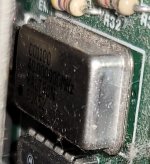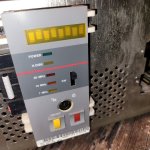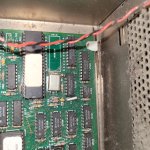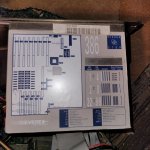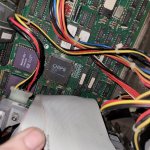What issues am I going to run into trying to overclock this board? It is currently a 386dx 20 . I have new a 40 mhz processor and coprocessor for it. Anything else I should be looking to replace? Cache? Ram? controllers? It has the turbo switch to half the speed.
Upcoming Events:
- VCF South West - June 14 - 16, Davidson-Gundy Alumni Center at University of Texas at Dallas
- VCF West - Aug 2 - 3, Computer History Museum, Mountain View, CA
- VCF Midwest - Sept 7 - 8 2024, Schaumburg, IL
- VCF SoCal - Mid February 2025, Location TBD, Southern CA
- VCF East - April 2025, Infoage Museum, Wall NJ
-
Please review our updated Terms and Rules here
You are using an out of date browser. It may not display this or other websites correctly.
You should upgrade or use an alternative browser.
You should upgrade or use an alternative browser.
Overclocking Everex 1816
- Thread starter bobconan
- Start date
krebizfan
Veteran Member
One major problem could be the speed of the expansion slots. The motherboard is listed as having a bus speed jumper but I think that would either divide the clock speed by 2 or by 3. Few expansion cards would function correctly if the bus speed is 20 MHz. Even 13MHz is likely pushing beyond what many cards can do.
What is the timing on the memory? My quick check shows that 40MHz 386s often shipped with 70ns memory but 70ns memory was rather standard at the time. I think there is a good chance that the memory you have would work at the higher clock speed mostly because Everex didn't build systems with marginal components.
What is the timing on the memory? My quick check shows that 40MHz 386s often shipped with 70ns memory but 70ns memory was rather standard at the time. I think there is a good chance that the memory you have would work at the higher clock speed mostly because Everex didn't build systems with marginal components.
I found it on UR: https://www.ultimateretro.net/en/motherboards/2297
We currently don't have a image of it and if you can post one I can tell you what chipset it has. Many early chipsets for the 386 only work up to 20MHz. Clocking it above this overclocks the chipset as well so you may run into issues there.
We currently don't have a image of it and if you can post one I can tell you what chipset it has. Many early chipsets for the 386 only work up to 20MHz. Clocking it above this overclocks the chipset as well so you may run into issues there.
I found it on UR: https://www.ultimateretro.net/en/motherboards/2297
We currently don't have a image of it and if you can post one I can tell you what chipset it has. Many early chipsets for the 386 only work up to 20MHz. Clocking it above this overclocks the chipset as well so you may run into issues there.
Everex STEP 386 REV. G
Everex STEP 386 REV. G is a motherboard based on the Chips & Technologies unidentified chipset. Get specs, BIOS, documentation and more!
That is actually the correct board for as mine is Rev G. I will work on getting an image .
Last edited:
Thanks, though we really need a picture of the whole board to match the diagram. If you dont want to take the board out of the case i completely understand, Either way to tell you the chipset, I need a pic that included the big square chips on the board.
If this can be dated as '87 it is a top of the line system. '88 still pretty high end '89 good but 33MHz cached systems existed. It is yours to do with what you like, but i would appreciate it for what it is. 40MHz AMD was a '91 mid-range thing.
If this can be dated as '87 it is a top of the line system. '88 still pretty high end '89 good but 33MHz cached systems existed. It is yours to do with what you like, but i would appreciate it for what it is. 40MHz AMD was a '91 mid-range thing.
Last edited:
Thanks, though we really need a picture of the whole board to match the diagram. If you dont want to take the board out of the case i completely understand, Either way to tell you the chipset, I need a pic that included the big square chips on the board.
Its a rev g . Listed here https://www.ultimateretro.net/en/motherboards/2301 . A diagram of the board is printed on top of the power supply in image 4
The bus chip is an 82c206 . The processor is a 25mhz DX.
GiGaBiTe
Veteran Member
The whole motherboard is going to be a limitation going from 20 to 40 MHz. It's not just the chipset, cache and RAM. The 74 series logic and the PAL/GAL/CPLD chips are also going to be limits. In the case of the PAL/GAL/CPLD, the parts could be rated fine to go faster, but if the equations and logic weren't designed to go that fast, it can throw the timing off and make them stop working properly. I would say that 25 MHz is probably doable, and 33 MHz would be a stretch. 40 MHz would need a whole lot of things to go right to work.
The ISA bus is another issue, you'll need to probe the clock pin on one of the slots to see what the bus speed is, and assuming you can get it booting at 40 MHz, you'd have to check the bus again to see if it's wildly out of spec. Most ISA cards from the late 80s to the mid 90s could tolerate ISA bus speeds in the ~10-13 MHz range, which is what many Pentium era boards would run the bus at. Earlier 8 bit ISA cards tended to be more speed sensitive because they were usually designed for the original XT bus.
If you wanted to upgrade, a better option would be to get a clock doubling CPU like the Cyrix Cx486DLC2. You'd need a driver in DOS to toggle the clock doubling most likely, but it would keep the bus at 20 MHz. If you wanted to try bumping the bus speed up to 25 MHz, you could get a 486DLC2 at 50 MHz for a modest performance boost. The 387 would run at half of the processor speed though.
The ISA bus is another issue, you'll need to probe the clock pin on one of the slots to see what the bus speed is, and assuming you can get it booting at 40 MHz, you'd have to check the bus again to see if it's wildly out of spec. Most ISA cards from the late 80s to the mid 90s could tolerate ISA bus speeds in the ~10-13 MHz range, which is what many Pentium era boards would run the bus at. Earlier 8 bit ISA cards tended to be more speed sensitive because they were usually designed for the original XT bus.
If you wanted to upgrade, a better option would be to get a clock doubling CPU like the Cyrix Cx486DLC2. You'd need a driver in DOS to toggle the clock doubling most likely, but it would keep the bus at 20 MHz. If you wanted to try bumping the bus speed up to 25 MHz, you could get a 486DLC2 at 50 MHz for a modest performance boost. The 387 would run at half of the processor speed though.
There is a 10 mhz crystal on the board. Could this be a separate clock for the ISAbus? Are you familiar with the 82c206?The whole motherboard is going to be a limitation going from 20 to 40 MHz. It's not just the chipset, cache and RAM. The 74 series logic and the PAL/GAL/CPLD chips are also going to be limits. In the case of the PAL/GAL/CPLD, the parts could be rated fine to go faster, but if the equations and logic weren't designed to go that fast, it can throw the timing off and make them stop working properly. I would say that 25 MHz is probably doable, and 33 MHz would be a stretch. 40 MHz would need a whole lot of things to go right to work.
The ISA bus is another issue, you'll need to probe the clock pin on one of the slots to see what the bus speed is, and assuming you can get it booting at 40 MHz, you'd have to check the bus again to see if it's wildly out of spec. Most ISA cards from the late 80s to the mid 90s could tolerate ISA bus speeds in the ~10-13 MHz range, which is what many Pentium era boards would run the bus at. Earlier 8 bit ISA cards tended to be more speed sensitive because they were usually designed for the original XT bus.
If you wanted to upgrade, a better option would be to get a clock doubling CPU like the Cyrix Cx486DLC2. You'd need a driver in DOS to toggle the clock doubling most likely, but it would keep the bus at 20 MHz. If you wanted to try bumping the bus speed up to 25 MHz, you could get a 486DLC2 at 50 MHz for a modest performance boost. The 387 would run at half of the processor speed though.
I thought the 486DLC had an NPU build into it and there was a matched 87 dummy chip for it?
Last edited:
GiGaBiTe
Veteran Member
There is a 10 mhz crystal on the board. Could this be a separate clock for the ISAbus? Are you familiar with the 82c206?
I doubt it, the various bus clocks are usually cascaded off of a single source to keep everything in sync. I would think the 10 MHz crystal is maybe for the RTC or the GAL/PAL/CPLDs or something. I don't know what an 82c206 is, other than providing some system chipset functionality.
My best guess is that this ISA bus on that system runs at either 8 MHz (40/5) or 6.67 MHz (40/6). Most half decent multimeters these days can measure clock frequencies into the MHz range. If you probe pin B20 on the ISA connector, you can see what frequency its running at.
I thought the 486DLC had an NPU build into it and there was a matched 87 dummy chip for it?
No. The only chip that I'm aware of that does that is the Intel RapidCAD, which was basically a full 486DX with a 386 bus. The "Dummy" chip provided the FERR signal to the 387 socket for compatibility. The Cyrix 486SLC/DLC don't have FPUs, you need to use a 387/487 with them.
GiGaBiTe
Veteran Member
Assuming you can get the board to run reliably at 33 MHz.
What should I be looking out for?Assuming you can get the board to run reliably at 33 MHz.
GiGaBiTe
Veteran Member
What should I be looking out for?
I explained the potential issues up in post #8.
Limiting factor is going to be the motherboard ICs and chipset. You're overclocking them with the CPU speed increase, and if they don't tolerate it, it's not going to work.

